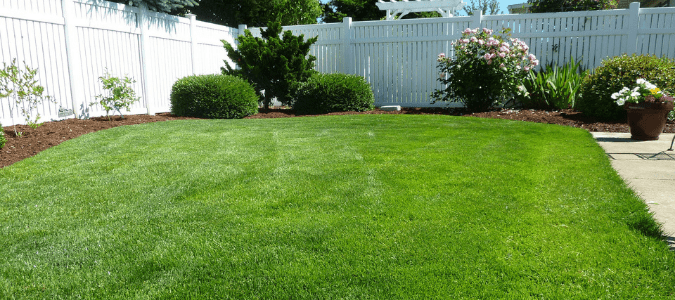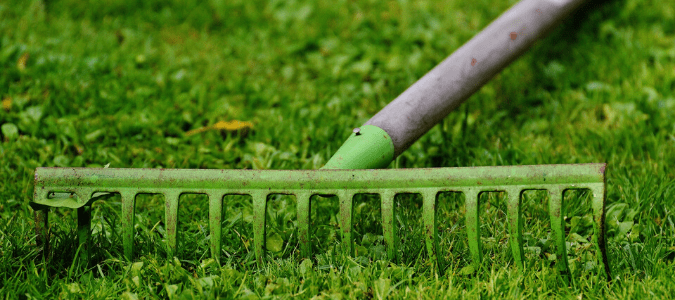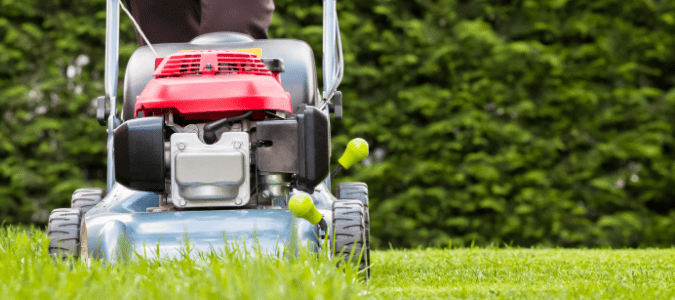Fall is a great time to take care of your grass and prepare it for the cold winter months ahead. So, when spring rolls around, it can thrive once again. Fertilizing your lawn is an important part of fall lawn maintenance. The best fall fertilizer for your grass will contain extra potassium to help your lawn survive the cold.
Is fertilizing your lawn in the early fall really so important? In a word, yes. Applying the right fertilizer to your grass at the right time will help it strengthen and rebuild any roots that were affected by drought or heat over the summer. Fertilizing will also help kill off weeds and feed your grass the nutrients it needs leading up to winter. Furthermore, applying only as much fertilizer as your grass needs and at the right time of year will reduce the risk of fertilizer runoff that could pollute your local waterways.
Which type of fertilizer you use on your lawn in the fall, and when to apply it, depends on the type of grass you have and your local climate. Warm-season grasses should be fertilized a bit earlier than cool-season grasses. Also, lawns in warmer regions can be fertilized a few weeks later than lawns in cooler areas.
Fertilizers are sold in formulas labeled with three numbers, such as 16-4-8. These numbers represent the ratio of nitrogen, phosphorus and potassium that the product contains by weight. Nitrogen helps grass blades grow thick and strong. Phosphorus helps grass roots grow. Potassium boosts your lawn’s ability to absorb needed minerals and nutrients from the soil.
The most exact way to determine the best fall fertilizer for your yard is to have a sample of your soil tested for its nutrient balance. Many people don’t realize how easy and inexpensive it is to get a soil test done. Instead, they ask for fertilizer recommendations from their local garden or hardware store about which product to use based on the type of grass they have in their yards. Hiring a lawn care service is an even better idea. A pro will know the best fertilizer products, timing and techniques for your particular lawn and climate.
If you choose to fertilize your yard yourself, a good rule of thumb is to apply fertilizer twice in the fall. One application in early fall, usually sometime in early or mid-September. Then, another application four to six weeks later. In hotter regions, the first fertilizer application can happen in late September or even early October. Then, the second application can happen in early November. Some people opt to apply fertilizer only once in the fall.
If you choose to fertilize only once in the fall, use a product that contains a higher proportion of nitrogen. If you choose to fertilize twice, use a product that is rich in nitrogen for your first application. Then, a product higher in potassium for the second application. This will help the grass’s roots grow strong and store up as much as possible in trace nutrients from the soil.
Check the numbers on the fertilizer product you choose to make sure the nitrogen number is higher for the early fall product and the potassium number is higher on the product you’ll use a month later. The middle number, representing phosphorus content, should be proportionately low on any product you use unless you have a soil test done that shows low phosphorus in the soil in your yard.
Whichever fertilizer you use, it should be distributed evenly over the entire lawn for the best results. Many people choose to use a broadcast spreader to cast an even layer of product over the yard. Each type and brand of fertilizer is a little different, so be sure to read and follow the directions on the package to make sure you know how much fertilizer to apply to your yard.
Knowing how much fertilizer to use on your lawn can be tricky, since doing the proper calculation requires complex math and careful reading of product labels. There are many fertilizer charts available online to help you calculate. That said, many people go by the general rule of thumb of applying one-half to one pound of nitrogen per 1,000 square feet of lawn.
You can also ask for a recommendation at your local garden store for how much fertilizer to use based on the specific product you buy. Or, you can hire a lawn care professional to handle the task for you, including the intricate calculations. Signing up for ongoing lawn service from a reputable company is a simple way to keep your lawn healthy through every season. And, it takes the work and the headache off your plate so you can just enjoy your yard.
Fall Lawn Treatment Options for Lush Grass
There are many fall lawn treatment options for your grass, based on what type of grass you have and what shape it’s in by the end of summer. Do you have a warm-season grass, like bermuda grass, St. Augustine or zoysia? Or, do you have a cool-season grass like rye or fescue? Is your lawn in generally good shape, or did it suffer over the summer from heat and lack of rain? Does it have thin spots, yellow patches, lots of weeds or other problems? The answers to these questions will help you determine the best fall lawn treatments for your lawn, to help it withstand the cold of winter and thrive again in spring.
Fertilizing your grass in the fall is a common and important step in fall lawn maintenance, but it’s not the only one. You can also treat your lawn for weeds with a pre-emergent herbicide. This will help help keep cool-season weeds from popping up during winter. It’s best to apply a pre-emergent while weeds are still in seed form, before they begin to grow. Early September is the best time to apply pre-emergent to your lawn. But, applying it anytime in fall will still give your yard some benefit.
If you’re planning to apply a pre-emergent and fertilize your lawn around the same time, it’s best to fertilize first. Water it in and then wait a couple of days before spreading the pre-emergent over the grass.
Another helpful fall lawn treatment is aerating the lawn. Lots of people know about aerating in spring to break up compacted soil and increase water flow and oxygen to the lawn’s roots. But, aerating can be beneficial in fall, too. Aerating twice a year in both spring and fall is an especially good idea if your soil has high clay or sand content. A screwdriver pushed into the soil in your lawn should be able to easily go in at least a couple of inches. If it’s hard to push a screwdriver even this short depth into your soil, that’s a good sign that the soil is compacted and needs aeration.
Keep up with mowing and watering throughout the fall, to keep your grass at its healthiest in preparation for winter. If the idea of continuing to mow and water while also having to think about fertilizing, applying pre-emergent and aerating the soil seems like too much, consider hiring a professional lawn service to keep your lawn healthy year-round. Lawn care professionals take the guesswork and the labor out of your lawn care, so you can enjoy a beautiful, healthy lawn.
DIY Fall Lawn Maintenance Steps
Fall lawn maintenance doesn’t have to be difficult. But, it does require some know-how about products, techniques and timing to keep your lawn at its best throughout all the seasons of the year. Here’s a list of steps that any do-it-yourself homeowner can follow to maintain their lawn in the fall and ensure lush grass the following spring.
- Aerate your lawn in early or mid-September if the soil is compacted. This will loosen up the soil and help the grass roots receive as much water, oxygen and trace nutrients from the soil as possible.
- Fertilize in mid-September (or a bit later, if you live in a hot area), using a nitrogen-rich fertilizer product.
- Apply a pre-emergent weed killer to your grass a few days after fertilizing to head off the growth of winter weeds. But, be aware of how long pre-emergents last and when to reapply this product.
- Consider applying a second round of fertilizer in mid- to late-October, with a higher potassium content. This will help your grass grow stronger roots that can absorb more nutrients from the soil and store them up for a long winter.
- Keep mowing and watering regularly throughout the fall to help your grass rebuild strong roots after the heat of summer. This will also help to choke out winter weeds, since the best way to keep weeds at a minimum is to have lush, thriving grass.
Many people don’t have the time or the confidence in their lawn care know-how to keep up with all of these fall lawn maintenance tasks, so they hire ongoing professional lawn care. This is a great way to ensure that your lawn has everything it needs in every changing season, so it can come back thick, green and beautiful every spring.
ABC Can Keep Your Grass Healthy
There are a number of reasons why homeowners prefer not to take care of their yard themselves. It takes a lot of hard work, knowledge and time to get your lawn just right. Instead of spending your free time working on your yard, contact ABC Home & Commercial Services. We offer a variety of lawn care services, including fertilization, aeration and regular mowing.



